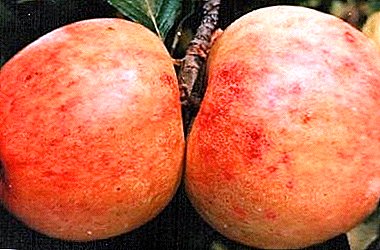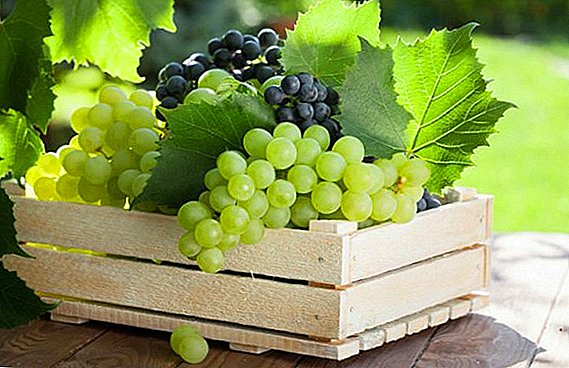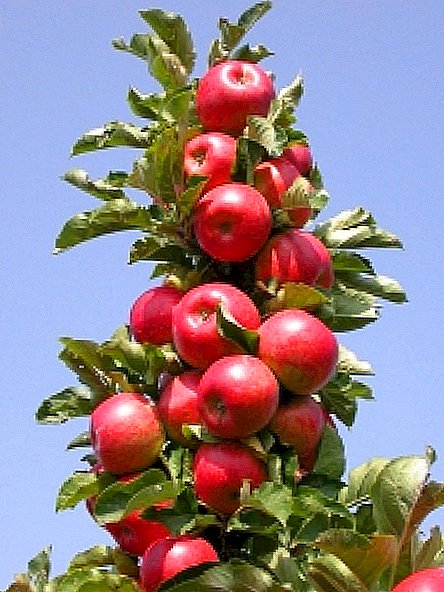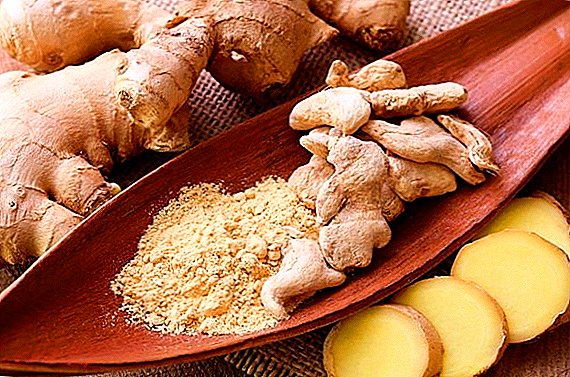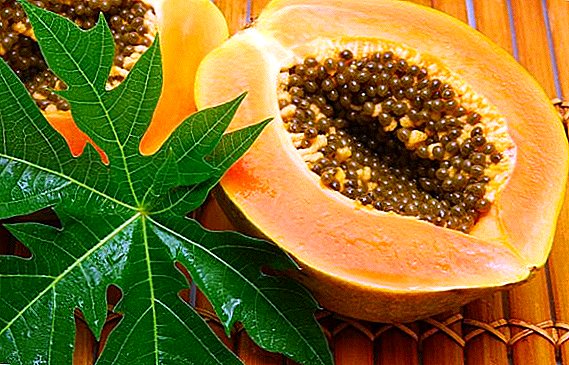 Americans call the fruit papaya "fruta bomb." And for good reason.
Americans call the fruit papaya "fruta bomb." And for good reason.
These large yellow-green fruits with a pleasant melon aroma gradually conquered the whole world.
They can easily be seen in the markets in every corner of the globe, and the planting of ten-meter palm-like trees from native America has already reached the South Caucasus. It was there, on the Black Sea coast, that experimental plantations were planted.
What kind of fruit is this - papaya, what makes it so attractive, what useful properties does it have, and why does beauty adore it?
Did you know? In everyday life papayas nicknamed melon or breadfruit. These nicknames are explained by the taste of fresh fruit, resembling a melon, and the aroma of fresh bread that spreads from baked fruit.
Calorie and chemical composition of papaya
The secret of the popularity of huge edible fruits, the length of which is about 35 cm, lies in their chemical composition. It turns out that papaya pulp contains almost all the elements of the periodic table, which explains the American nickname of the fruit. Yes, yes, it is the fruit bomb that I want to call it, more precisely, the vitamin one.
After all, eating such a fruit, a person receives not only taste pleasure, but also a charge of substances necessary for health. If we take into account that the weight of one smallest fruit is about 500 g, then it is quite possible to count on getting the daily rate of many elements. But there are 7-kilogram giants on the tree.  In large quantities, papaya contains vitamin C (up to 68%), which is essential for redox reactions and the protective functions of the body. And also trace elements and amino acids. If we speak in terms of numbers, then the contents of 100 g of edible parts of papaya look like this:
In large quantities, papaya contains vitamin C (up to 68%), which is essential for redox reactions and the protective functions of the body. And also trace elements and amino acids. If we speak in terms of numbers, then the contents of 100 g of edible parts of papaya look like this:
Vitamins:
- A - 47 µg;
- B1 - 0023 mg;
- B2 - 0,027 mg;
- B4 - 6.1 mg;
- B5 - 0.191 mg;
- B6 - 0.038 mg;
- B9 - 37 µg;
- C - 60.9 mg;
- E - 0.3 mg;
- Lycopene - 1828 mcg;
- lutein - 89 mcg;
- K - 2.6 mcg;
- PP - 0.357 mg.
 Macronutrients and trace elements:
Macronutrients and trace elements:- potassium - 182 mg;
- copper - 45 mcg;
- magnesium - 21 mg;
- calcium - 20 mg;
- phosphorus - 10 mg;
- sodium - 8 mg;
- manganese - 0.04 mg;
- selenium - 0.6 mcg;
- iron - 0.25 mg;
- Zinc - 0.08 mg.

Papaya is not the only exotic in our area - lychee, rambutan, mangosteen, dragon eye, durian, kumquat, actinidia (it is kiwi), pepino, loquat, zizifus, physalis, citron, okra. Many of them are already cultivated in homestead farms or as indoor plants.Replaceable and essential amino acids:
- arginine - 0.01 g;
- valine - 0.01 g;
- histidine - 0.005 g;
- isoleucine - 0.008 g;
- leucine - 0.016 g;
- lysine - 0.025 g;
- methionine - 0.02 g;
- threonine, 0.011 g;
- tryptophan - 0.08 mg;
- phenylalanine - 0.009 g;
- alanine, 0.014 g;
- aspartic acid - 0.05 g;
- glycine, 0.018 g;
- glutamic acid - 0.033 g;
- proline - 0.01 g;
- serine - 0.015 g;
- tyrosine - 0.005 g.
 Fatty acid:
Fatty acid:- omega-3 - 0.047 g;
- omega-6 - 0.011 g;
- lauric acid - 0,002 g;
- myristic - 0.013 g;
- palmitic - 0.06 g;
- stearic - 0.004 g;
- palmitoleic - 0.038 g;
- oleic - 0.034 g;
- linoleic - 0,011 g;
- linolenic - 0.047 g.
 Digestible carbohydrates:
Digestible carbohydrates:- fructose - 3.73 g;
- glucose - 4.09 g;
- mono - and disaccharides - 7,82,
Nutrients also contain dietary fiber (1.7 g), water (88 g) and ash (0.39 g). A total of papaya consists of 11 g of carbohydrates, 0.26 g of fat and 0.47 g of proteins with a caloric content of 43 kcal. Many consider the fruit to be dietary and prefer it as a source of vitamins necessary for the body during diets.
Important! The flesh and seed of immature papaya fruits have a contraceptive effect, and when consumed in large quantities can trigger an abortion.
How is papaya useful for the body?
Sweet exotic fruits, strong wood and papaya foliage have found their application in many spheres of human activity. For example, ropes are made from bark and leaves. Fruits (which, according to scientists, are berries) because of their nutritional value, are recommended for treating a number of ailments. The fruits are especially useful for people with eye diseases and pregnant. 
For sight
The components of papaya allow you to work on the perspective of the eye, saving them from future blindness. In adulthood, due to the specific working conditions, retinal dystrophy often occurs in people, leading to loss of vision. The systematic use of fruit pulp prevents the development of these processes, and beta-carotene helps to improve the work of the eye muscles.
During pregnancy
The benefits of papaya for pregnant women can be talked about incessantly.
First, it is a real storehouse of essential vitamins and minerals.
Secondly, folic acid in the composition of the fruit prevents the development of anemia, normalizes blood circulation, which is especially important for the formation of a healthy fetus.
Third, in addition to stimulating vigilance, the fruit cleanses the body of toxic substances, not allowing them to accumulate.
Fourth, the pulp is recommended for those who have stretch marks on the skin.
However, expectant mothers should be wary of choosing a useful berry. The fact is that in green fruits with hard skin there are large quantities of peptin, which provokes intensive uterine contractions, with the result that even a small fraction of the papaya eaten can lead to premature birth. If there are no ripe yellow-green specimens, and you really want to eat exotica, bake it in the oven or stew it.
If there are no ripe yellow-green specimens, and you really want to eat exotica, bake it in the oven or stew it.
Did you know? Papaya was found in the pulp of the papaya, with which the ancient Indians softened the toughest and seemingly unusable meat.
Papaya in cooking: how to clean, how to eat and with what
Berries of the so-called melon tree are often eaten raw, because during heat treatments of any type some of the nutrients are lost. Sweet pinkish sweet flesh is used to make salads and juices.
Also, jams, preserves, compotes, marinades and even ice cream are made from it. A few drops of juice are added to the broth so that the fibers of the meat become tender and melt in the mouth.
But when you hold such a miracle in your hands for the first time, it is not clear how to clean, and even more so there is this papaya. For a start, we note that only the pulp is related to the edible parts of the fruit. Skin and seed are thrown away. Cooks use different ways to clean the berries. In most cases, this process is like cutting a melon: the fruit is cut in half, the grains are removed with a spoon, the parts are divided into slices and removed from each skin.
Other mistresses share the experience of cutting the inside of the squares right on the skin of the cloves. After the manipulations with a sharp movement, the bottom is cut off directly on the plate. And in the resulting sweet figures for convenience stick skewers.
If you do not have a knife or a spoon, which, by the way, you can also choose the pulp on a plate, then the removal of the skin and bones is done by hand.
Did you know? In some Asian countries, papaya seed is used as black pepper.Now let's figure out how to eat papaya. The uniqueness of an exotic fruit is in the ease of combining it with meat dishes, desserts and vegetables. And the fruit is tasty, both raw and braised, roasted or baked. For example, green exotics are cut in such a way that juice is drained from them, and later the pulp is used as zucchini. In this case, the flesh is suitable for frying, stewing and boiling. Moreover, this wonderful fruit can be baked like a shish kebab on the fire.
The use of papaya in traditional medicine
Folk healers recommend infusions of papaya blossoms for the treatment of colds and as an expectorant.
The antimicrobial properties of the milky juice of green fruits are used to treat deep and poorly healing wounds. For example, African peoples harvest unripe papayas to obtain this medicinal drug. On average, from one such berry you can get about 10 g of liquid, for long-term storage it is dried in the sun to brown. And Peruvian healers talk about the unique ability of the leaves to tighten the scars on the skin right in front of your eyes.  There are many methods of losing weight with the help of these fruits. Also, traditional medicine advises with their help to get rid of heart ailments, ulcers of the digestive tract, colitis, asthma, burns, dermatitis; use them to improve the functions of the liver and normalize blood sugar, cleanse the intestines, stimulate the immune system.
There are many methods of losing weight with the help of these fruits. Also, traditional medicine advises with their help to get rid of heart ailments, ulcers of the digestive tract, colitis, asthma, burns, dermatitis; use them to improve the functions of the liver and normalize blood sugar, cleanse the intestines, stimulate the immune system.
Juice treats the skin for insect bites, eczema, relieves pain, and in some countries it is prescribed for spinal ailments, hernias, and osteochondrosis. From the seeds of the folk doctor prepare anthelmintic agents.
Important! Fresh papayas should be stored in the refrigerator, but they are not intended for long-term savings. After 14 days, the fruits lose their usefulness.
How to use in cosmetology
Globally, papaya is an essential ingredient in face and hair cosmetics. On sale there are many masks and creams with exfoliating effect from the extract of these fruits. Also extracts from the seed are used in cosmetology to improve the condition of the epidermis, skin regeneration, removal of pigmentation, warts, scars and freckles.
Nowadays, a popular enzyme peel is also performed with the participation of acids produced by the melon tree. The procedure has a beneficial effect on the skin, tightens pores, removes acne and stimulates collagen production. After several sessions, the face noticeably rejuvenates, becomes clear, and becomes healthy.  But this is not a complete list of the amazing properties of the miracle berries. No wonder that the aborigines called papaya "health trees". In high-quality cosmetics with a bleaching effect, you will also definitely find an extract from their pulp. It is present in shampoos, and hair balms, and even in shaving products and toothpastes.
But this is not a complete list of the amazing properties of the miracle berries. No wonder that the aborigines called papaya "health trees". In high-quality cosmetics with a bleaching effect, you will also definitely find an extract from their pulp. It is present in shampoos, and hair balms, and even in shaving products and toothpastes.
Papain has a destructive effect on keratin, thus slowing down unwanted vegetation. These properties of fruits are used in a series of cosmetic products for skin care after epilation.
Did you know? The people of Congo are still wrapping meat in papaya leaves, which is an alternative to our usual fridges..Among the ladies' society, papaya oil, which has a moisturizing, cleansing and anti-bacterial effect, deserves special respect. It is easily absorbed into the layers of the epidermis and in conjunction with papain normalizes the sebaceous glands. Beauticians recommend it for the care of normal and oily skin.
Women who regularly make masks for hair oil of these fruits, can boast a magnificent, breathing health shock. The liquid heals damaged split ends, strengthens hair follicles and nourishes them. To get the effect, just a few drops are added to the basic care products.
Contraindications
Exotic papaya can also harm, especially those who do not know how to choose ripe high-quality fruits and are prone to allergic reactions, there are no other contraindications. Especially should be wary of green berries - their juice and pulp are poisonous. Once in the body, they provoke a strong poisoning, cramps in the lower abdomen, indigestion and allergies. In large quantities, the substance turns into a potent poison.
Many long-known and familiar plants turn out to have a mass of useful properties. One only needs to look at nettles, maple, kalanchoe, black raspberries, beets, even tops, onions, carrots, apples, acacia, osot, purslane, peas, plums, mallow, swan, beans, mountain ash red, black, pear, parsley, dill and to many others - and skillfully applying them to their intended purpose can significantly improve their health
Therefore, only ripe fruit with soft or elastic skin should be placed on the table, always yellow-green or orange and with pink tender inside. Juice - white and homogeneous consistency. If it is watery and has lost color, it is better not to eat such papaya. If you have any doubts about the maturity of the exotic, cook a fried, steamed or boiled dish out of it.






